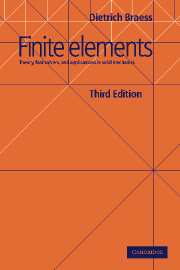Book contents
- Frontmatter
- Contents
- Preface to the Third English Edition
- Preface to the First English Edition
- Preface to the German Edition
- Notation
- Chapter I Introduction
- Chapter II Conforming Finite Elements
- Chapter III Nonconforming and Other Methods
- Chapter IV The Conjugate Gradient Method
- Chapter V Multigrid Methods
- Chapter VI Finite Elements in Solid Mechanics
- References
- Index
Chapter II - Conforming Finite Elements
Published online by Cambridge University Press: 01 March 2010
- Frontmatter
- Contents
- Preface to the Third English Edition
- Preface to the First English Edition
- Preface to the German Edition
- Notation
- Chapter I Introduction
- Chapter II Conforming Finite Elements
- Chapter III Nonconforming and Other Methods
- Chapter IV The Conjugate Gradient Method
- Chapter V Multigrid Methods
- Chapter VI Finite Elements in Solid Mechanics
- References
- Index
Summary
The mathematical treatment of the finite element method is based on the variational formulation of elliptic differential equations. Solutions of the most important differential equations can be characterized by minimal properties, and the corresponding variational problems have solutions in certain function spaces called Sobolev spaces. The numerical treatment involves minimization in appropriate finite-dimensional linear subspaces. A suitable choice for these subspaces, both from a practical and from a theoretical point of view, are the so-called finite element spaces.
For linear differential equations, it suffices to work with Hilbert space methods. In this framework, we immediately get the existence of so-called weak solutions. Regularity results, to the extent they are needed for the finite element theory, will be presented without proof.
This chapter contains a theory of the simple methods which suffice for the treatment of scalar elliptic differential equations of second order. The aim of this chapter are the error estimates in §7 for the finite element solutions. They refer to the L2-norm and to the Sobolev norm ∥ · ∥1. Some of the more general results presented here will also be used later in our discussion in Chapter III of other elliptic problems whose treatment requires additional techniques.
The paper of Courant [1943] is generally considered to be the first mathematical contribution to a finite element theory, although a paper of Schellbach [1851] had appeared already a century earlier. If we don't take too narrow a view, finite elements also appear in some work of Euler. The method first became popular at the end of the sixties, when engineers independently developed and named the method.
- Type
- Chapter
- Information
- Finite ElementsTheory, Fast Solvers, and Applications in Solid Mechanics, pp. 27 - 104Publisher: Cambridge University PressPrint publication year: 2007

